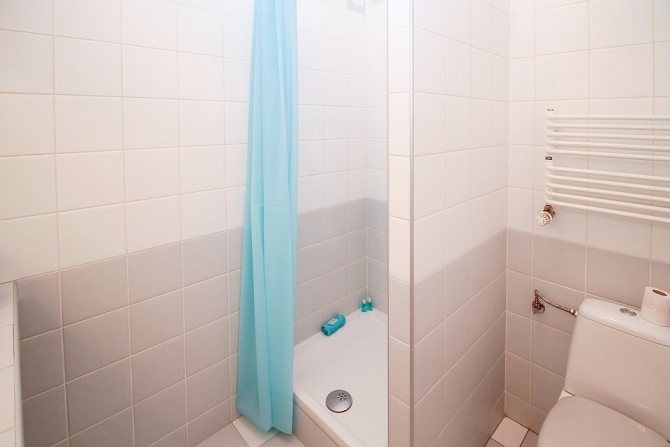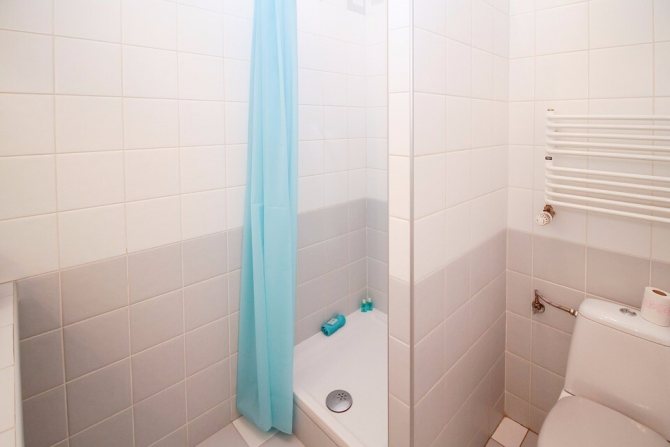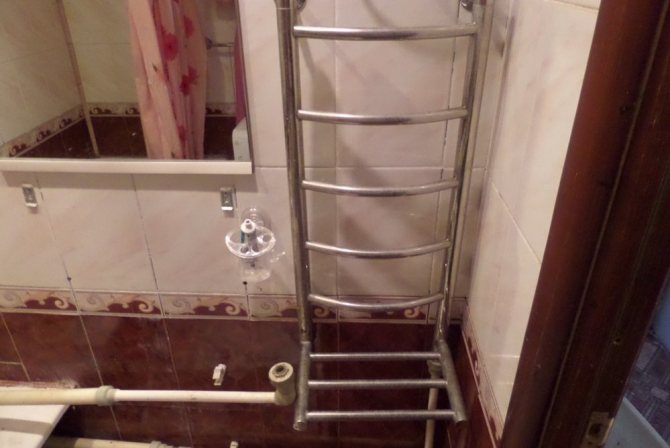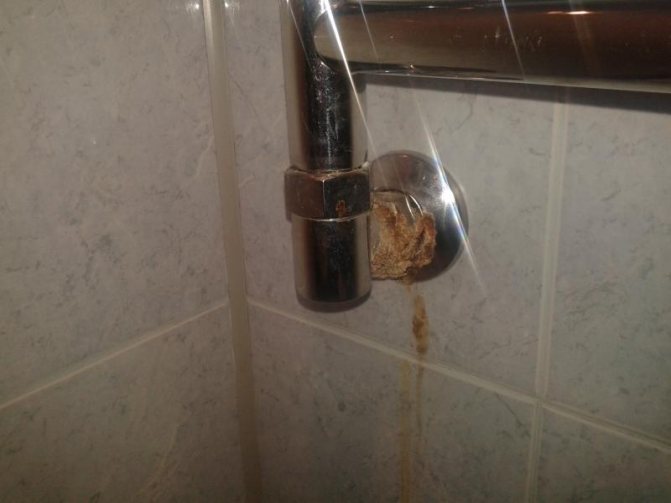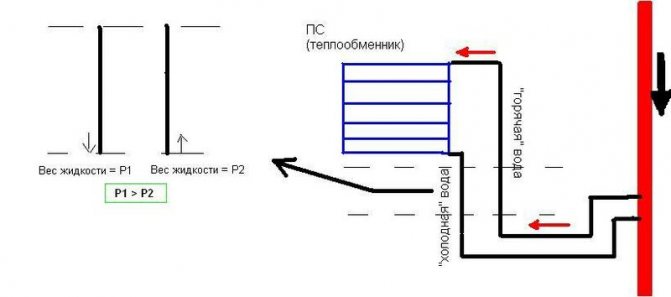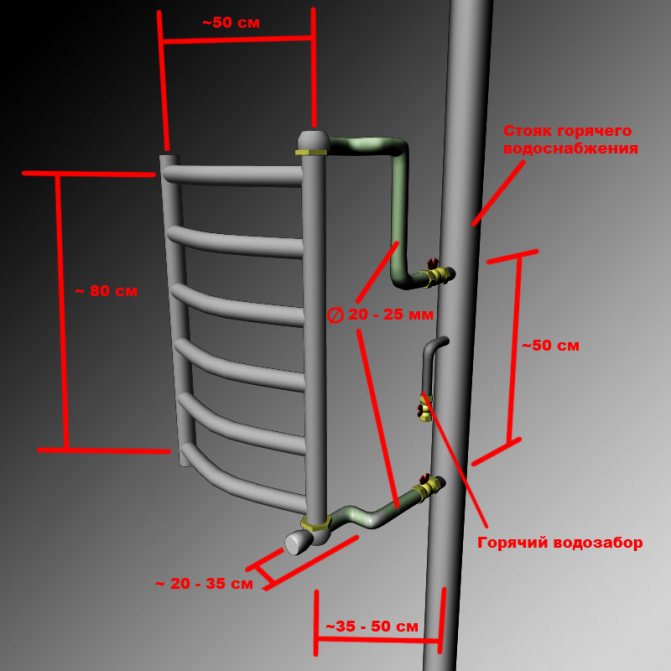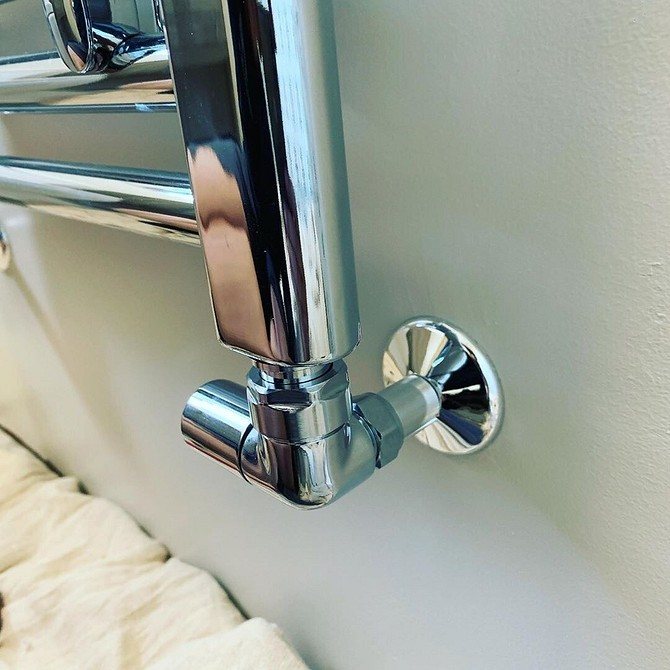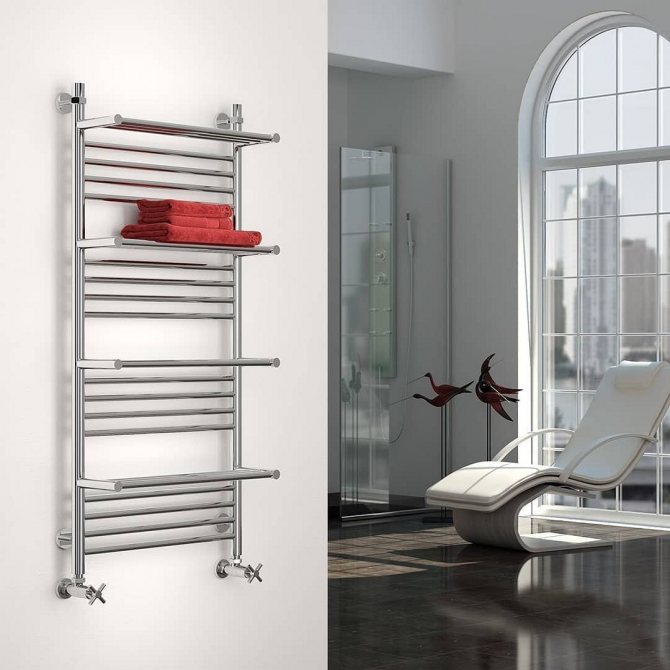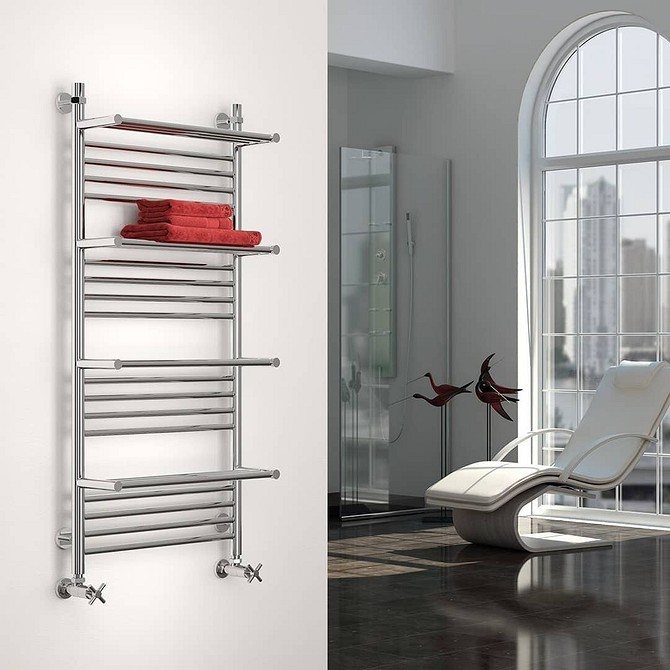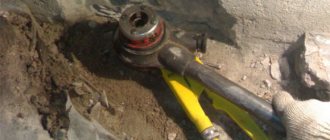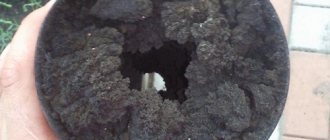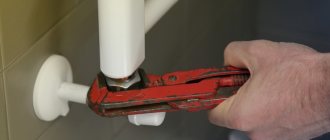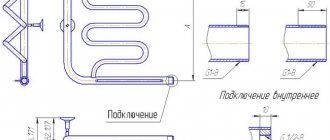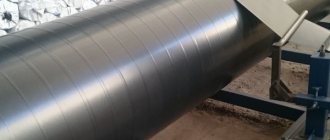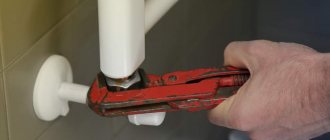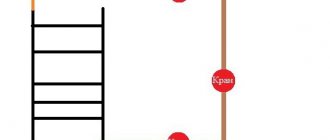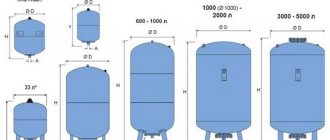Varieties of modern heated towel rails
There are two main types of heated towel rails: electric and water. Both the first and the second are performed in a very different design, of different sizes, colors, configurations: from a simple curved tube to exquisite models that look more like an interior decoration, but they do their job pretty well.
The device of different types of heated towel rails, of course, is fundamentally different.
In the first case, the device is heated with electricity, in the second, hot water circulates through the pipes. The installation procedure for electric and water models also has significant differences.
What needs to be considered before installing the water model?
The heating medium in water models of heated towel rails is hot water. Most often, the device is connected to a hot water supply system, but this is not always possible. When deciding how to properly install a heated towel rail in the bathroom, such moments should be clarified in advance.
For example, in houses where there is no centralized heating, gas water heaters are used. In such rooms, water heated towel rails are connected to the central heating system. This is not very convenient, since the device works for heating only during the heating period, the rest of the time it is a regular towel rack.
If an electric boiler is used to heat water in the house, it makes sense to purchase a special double-circuit model.
But the owners of private houses with a completely autonomous heating and hot water supply system are much more free in their choice.
If a decision is made to make a heated towel rail part of the heating system of an apartment building, it should be installed in the summer, while the heating season has not yet begun. Usually, utilities are extremely reluctant to agree to turn off the heating of the entire house in the winter cold for the sake of installing this device, which is not necessary for life. And the lack of heating for several hours will hardly please the neighbors.
Before installing a heated towel rail, you need to find out if there is water in the heating system. Usually it is drained for the summer, but this is not always done. You will have to ask the local utilities to check this and turn off the water if necessary.
When installing a heated towel rail as part of the household plumbing, you will also need to shut off the hot water entering the house. Old models of heated towel rails are usually not equipped with taps and a bypass that allows water to bypass the device, so you cannot simply remove it, you will have to ask for the help of local plumbers.
In some cases, it is possible to shut off the water in the water supply or heating system on your own, but for this you need to know exactly how to do it, as well as notify the local public utilities about your “initiative” and obtain their consent.
Finding out how to install a suitable heated towel rail in the bathroom, even before purchasing it, you need to decide on how to connect it. It can be:
- bottom;
- lateral;
- diagonal (for models of the “ladder” type);
- in the center of the bottom.
In the first case, the place where the device is connected to the water supply is at the bottom, and in the second, on the side. Today, water pipes are hidden in the wall or masked with a partition, leaving only places outside for connecting the necessary plumbing.This is how the models with side connection are installed, although the process is quite laborious. It still makes sense to try: the bathroom looks much more attractive this way.
The bottom connection is typical for old houses in which the project provides for the installation of a heated towel rail. The power of the models with the bottom connection is about 10% lower than that of the analogs with the side connection.
To increase the efficiency of the equipment, it makes sense to think over the modification of the water supply system and put a model with a side connection.
Sometimes the diameter of the nozzles of the heated towel rail and the corpse pipe does not match. Special adapters are used to connect them. The diameter of such an adapter must be equal to or greater than the diameter of the water pipes. Otherwise, overpressure may develop in the system, which is fraught with an accident, leaks and other unpleasant problems.
An important parameter is the axial dimensions of the heated towel rail, i.e. the distance separating its entry and exit. Be sure to take into account the diameter of the water pipe in order to select the model of a heated towel rail of the appropriate size. The presence of adapters complicates the installation process and degrades the appearance of the device.
In addition, the risk of leaks increases. If you cannot do without adapters, you should pay special attention to sealing each connection. When choosing taps and fittings, you should take into account the material from which the water pipes are made.
The combination of different metals can cause electrochemical corrosion. In this respect, plastic pipes are much easier to work with.
It is believed that chrome models of towel warmers are more durable than other options. In addition, such devices are characterized by a higher heat transfer.
Heated towel rail leaks: possible causes
A heated towel rail, or, as it is also called, a coil, is located in the bathroom and is a curved pipe through which hot water passes. It heats the room, and at the same time it is possible to dry wet towels and linen on it. Another important technical function is performed by this equipment: it forms a compensating loop. That is, with an increase in the temperature of the water that flows through the pipe, the pipe expands, and with a decrease in temperature, it narrows.
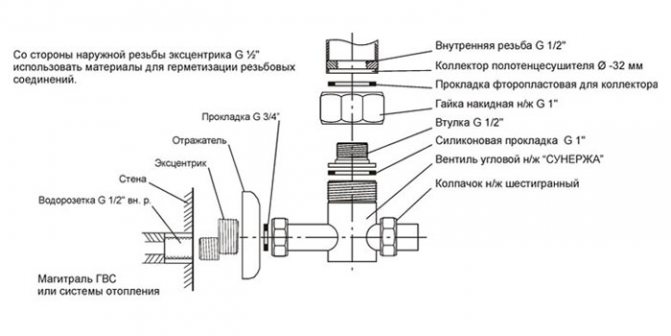
Heated towel rail valve connection diagram.
So, the usual attribute of the bathroom is quite functional and important for the heating system. But if it so happens that a heated towel rail is leaking, what to do in such a situation? Where should you start troubleshooting? After all, no one wants a flood in their own apartment and the appearance of troubles with neighbors. This means that the coil needs to be repaired or changed. In this regard, it is necessary to have some idea of the device itself.
Heated towel rail: what is it
Until recently, few people thought that the coil can be replaced if it does not suit the owners in terms of its location, design or dimensions. These were the rules of construction and living conditions in state apartments before. Even when it started to leak and leave rusty spots on the wall and towels.
But today the consumer can choose the product that he likes from a huge assortment on the sanitary ware market. You can install the coil yourself or turn to professionals for help. Moreover, apartments already have inexpensive models that are not able to give maximum comfort to their owners. But if the coil does an excellent job with its main functions and is also a great part of the decor in the bathroom, then you can try to repair it.
Back to the table of contents
Types of heated towel rails
Heated towel rail connection unit.
- A water appliance, this type is the most popular, usually it is connected to a heating system, less often to a hot water supply system. Its operation depends entirely on the heating season or on the availability of hot water in the house. If the device is connected to a water supply system, then its possible transfer is completely excluded, because this can adversely affect the water supply of the entire riser. But if it is connected to the heating system, then the transfer is allowed.
- An electrical appliance works in the same way as a conventional electric heater. Most often it is installed when connection to water is difficult or impossible. You can install such a device anywhere in the bathroom; in addition, its heat transfer can be adjusted.
- The combined type belongs to the most expensive and modern types, it is heated by central heating in winter, and in summer it works on the principle of a boiler, that is, from water heated by a built-in electric heater.
Connection diagram for a stainless steel heated towel rail.
The material used for the manufacture of heated towel rails:
- brass;
- copper;
- aluminum;
- stainless steel.
Experts advise paying special attention to the material from which the device is made. The most durable and reliable model is considered to be stainless steel. They learned to make high-quality domestic heated towel rails from this material. As for foreign manufacturing companies, due to a shortage of steel, they produce reliable devices from chrome-plated brass.
Forms of heated towel rails:
- U-shaped;
- M-shaped;
- in the form of a ladder;
- in the form of a coil.
Heated towel rail device.
Electric towel drying devices, in addition to the above-mentioned forms, have more complex ones. This includes models with movable bars, in the form of a lattice, comb or butterfly. There are even more complex models that modern interior designers offer their customers, but their price is very high.
It is important to know that a heated towel rail can be made from a seam or seamless pipe. Seamless patterns are much more expensive than the first types, because uniquely seamless pipes flow less often, and only at the joints, therefore, they have a longer service life and high quality in use of the product.
Basically, consumers today use a water heated towel rail, because this type is the most affordable for the consumer, it is easy to use and the installation of the device itself has been familiar to everyone for many years. Electric and combined models are generally not popular due to the complexity of the installation work and the high cost.
Back to the table of contents
Possible causes of a heated towel rail leak
Heated towel rail installation diagram.
Not only the old model can leak, but also a completely new one, just installed. The reasons why a heated towel rail is leaking can be completely different in both cases. To reduce the creation of an emergency situation or to avoid it, it is necessary to timely identify a possible hazard and, most importantly, eliminate it. The reasons that the heated towel rail drip applies to all types of models: plumbing, electric and combined.
An old heated towel rail leaks under the following circumstances:
- Damage at the junction of the device with the main pipeline or the beginning of corrosion of the pipe body can cause the heated towel rail to flow. Most often, in this case, there is a constant leakage, which can be easily detected with the subsequent replacement of the system. But this requires periodic preventive inspection of the entire device.
- Water hammer or sudden increase in pressure within the system.To prevent such a phenomenon, it is recommended to install a hydraulic protection system at the inlet of the water supply.
- Mechanical damage to the device by a third-party object, which was not immediately detected. Most often, such accidental damage occurs during repairs. Therefore, at the end of all repair and other work, it is recommended to check, including the bathroom, whether the heating system is leaking anywhere and whether it has been mechanically damaged.
- Wear in places of sealing. Usually, the installation in this case proceeds gradually, but as soon as this is detected, the entire seal should be replaced.
Taps for heated towel rails.
A new heated towel rail leaks under the following circumstances:
- The quality characteristics of the device absolutely do not coincide with the parameters of the installed heating system. In this case, the heated towel rail must be definitely replaced, and as soon as possible.
- Poor quality installation work. After the completion of all installation work, it is necessary to regularly carry out a preventive inspection at the joints of the device. If moisture is detected, it means that the system is flowing somewhere, then you need to seek help from a specialist or eliminate the malfunction yourself.
- The product has a manufacturing defect. Here, potential consumers are advised to take the choice of the installation seriously and purchase products that have a certificate of quality and guarantees. And if you find the slightest malfunction, contact the seller to replace the defective device.
Back to the table of contents
What you need to know when choosing and installing a heated towel rail
The procedure for installing a new heated towel rail.
Selecting a heated towel rail:
In order not to leak a heated towel rail, the choice of the product should be done correctly, and the piping should be carried out in accordance with existing standards. When choosing plumbing products that are directly related to plumbing, it is imperative to take into account some factors:
- What pressure in the water supply system is this model designed for?
- What pressure exists in the water supply system where the selected sample will be installed.
The magnitude of the pressure of the water supply heating system is regulated in regulatory documents. Mostly the coils are suitable for a two-pipe heating system, but not for a hot water system. Through one pipe at the junction, water enters the heated towel rail, and through the other it leaves. In the heating system, water is purified from abrasive substances and other impurities, which is not in the hot water supply system.
Modern technologies provide an excellent opportunity to install any model so that the owners will not face any troubles for a long time. Usually the coil is connected to the heating system by means of a special nut, or, as it is also called, American. As a rule, such a high-quality connection can last for more than a dozen years. Otherwise, it will be necessary to make urgent repairs to the system or even need to completely replace it.
Consumers are advised to choose the right model for their bathroom, correctly install it on their own or with the help of specialists and take proper care of it during operation, so that in the future such an unpleasant situation is excluded when a heated towel rail is constantly flowing, causing unnecessary trouble and trouble for the owners.
Share a useful article:
bezsantexnika.ru
The procedure for installing a water heated towel rail
Installation of a water model of a heated towel rail is carried out in several main stages:
- Removing the old device.
- Bypass installation.
- Installation of the top and bottom faucet.
- Installation of a heated towel rail.
- Checking the connections for leaks.
Stage # 1: Removing the old device
So, by the beginning of work, the water in the system should already be reliably shut off.To remove an old heated towel rail, if it is welded to the pipes, you can use a conventional grinder, simply by cutting it off. It should be remembered that some of the pipes will have to be threaded, so you need to cut them taking into account these dimensions.
The grinder will also be needed to remove the device with a threaded connection, if it has “stuck” to the pipes over time. In other cases, the old heated towel rail is simply unscrewed from the pipes and removed from the brackets on which it hung.
Step # 2: Installing the bypass
A bypass is a special jumper connecting the inlet and outlet of the pipe to which the heated towel rail is connected. It is installed in front of the taps so that the flow of hot water through the pipes is not interrupted when the taps that separate the device from the hot water supply system are closed.
If there is no bypass in the system, for repairs or other manipulations with the device, you will have to turn off the water.
To install the jumper, you need a piece of pipe of a suitable size and diameter. Usually, a pipe with a smaller diameter is used than the dimensions of the pipes of the main line.
The bypass is welded to the pipes of the main line or screwed on with a threaded connection.
Stage # 3: Installing the top and bottom faucet
Before installation, you should purchase two shut-off valves, the thread diameter of which coincides with the diameter of the pipes on which it will be installed.
You can choose conventional taps, which translate to only two positions: “open” and “closed”, or use screw structures to regulate the flow of the coolant entering the device, i.e. the degree of its heating.
Another useful device that is recommended to be installed on a heated towel rail is the Mayevsky tap.
Automatic models of the Mayevsky crane cope with this task even without human intervention. It is very easy to determine that air has entered the device; in this case, the heated towel rail does not heat up enough or cools down completely.
If there are no threads on the pipes, it should be cut using a die with the appropriate characteristics. If there is a thread, but it looks old and worn, it also does not hurt to update it with a special tool to improve the quality of the connection.
Stage # 4: Installing a heated towel rail
Before installing a heated towel rail, consider placing it on the wall. To do this, use special brackets, telescopic holders or clamps. Usually, models from good manufacturers are equipped with the necessary materials and fasteners.
The brackets should be installed on the wall. Usually, for this, the attachment points are marked on the wall, holes are made with a drill, then the brackets are screwed on. Before starting work, read the manufacturer's instructions.
In some cases, a heated towel rail is first installed, and only then it is fixed on the wall.
When installing a heated towel rail, you must remember the special regulations. With a pipe diameter of less than 23 mm, a distance of more than 35 mm should be left between the pipe and the wall, and if the pipes of the device are thicker - more than 40 mm - the distance to the wall must be increased to 50 mm.
To connect the heated towel rail to the hot water system, you will need fittings. Angular or straight fittings are used, it depends on the design of the device and the type of its connection. Of course, all connections must be properly sealed to prevent leaks.
Conventional threads are traditionally sealed with linen thread. If enough material has been used for this, it will protrude slightly from the thread after screwing.
If screwing is very difficult, perhaps there is too much winding, but if the connection is easy to screw on, it is likely that you need to add a little more linen sealant.FUM tape is used for conical threaded connections.
When installing a heated towel rail, do not use excessive force to tighten all connections, so as not to accidentally damage the threads. In more detail, the process of installing a water heated towel rail is presented in the following video:
Step # 5: Checking the connections for leaks
After all the work is completed, you should again supply water to the system and check the operation of the device. It is advisable to provide maximum load on the device in order to detect even small leaks. In a situation where a heated towel rail is built into the heating system of the house, it is difficult to carry out such a check, because the installation is usually carried out in summer.
Leaks can only appear before the start of the heating season, when utility workers check the readiness of the system for winter, subjecting it to increased loads. To prevent leakage at a time when the tenants of the apartment are absent, the heated towel rail taps should always be kept closed.
Although the description of the procedure for connecting a heated towel rail looks simple, in practice, all operations require a professional approach. If the home owners do not have the appropriate skills, it makes sense to consult with an experienced plumber or entrust him with the entire range of work.
Why is the heated towel rail leaking
A heated towel rail, or, as it is also called, a coil, is located in the bathroom and is a curved pipe through which hot water passes. It heats the room, and at the same time it is possible to dry wet towels and linen on it. Another important technical function is performed by this equipment: it forms a compensating loop. That is, with an increase in the temperature of the water that flows through the pipe, the pipe expands, and with a decrease in temperature, it narrows.
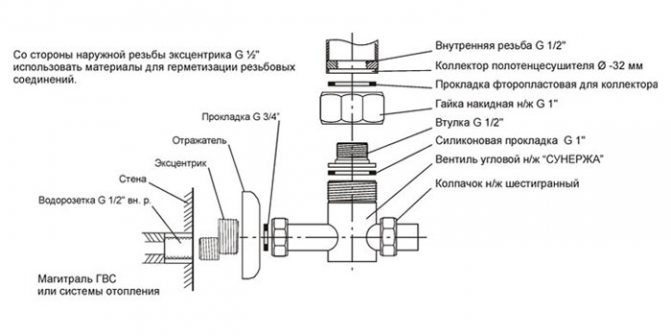

Heated towel rail valve connection diagram.
So, the usual attribute of the bathroom is quite functional and important for the heating system. But if it so happens that a heated towel rail is leaking, what to do in such a situation? Where should you start troubleshooting? After all, no one wants a flood in their own apartment and the appearance of troubles with neighbors. This means that the coil needs to be repaired or changed. In this regard, it is necessary to have some idea of the device itself.
Heated towel rail: what is it
Until recently, few people thought that the coil can be replaced if it does not suit the owners in terms of its location, design or dimensions. These were the rules of construction and living conditions in state apartments before. Even when it started to leak and leave rusty spots on the wall and towels.
But today the consumer can choose the product that he likes from a huge assortment on the sanitary ware market. You can install the coil yourself or turn to professionals for help. Moreover, apartments already have inexpensive models that are not able to give maximum comfort to their owners. But if the coil does an excellent job with its main functions and is also a great part of the decor in the bathroom, then you can try to repair it.
Types of heated towel rails
Heated towel rail connection unit.
- A water appliance, this type is the most popular, usually it is connected to a heating system, less often to a hot water supply system. Its operation depends entirely on the heating season or on the availability of hot water in the house. If the device is connected to a water supply system, then its possible transfer is completely excluded, because this can adversely affect the water supply of the entire riser. But if it is connected to the heating system, then the transfer is allowed.
- An electrical appliance works in the same way as a conventional electric heater.Most often it is installed when connection to water is difficult or impossible. You can install such a device anywhere in the bathroom; in addition, its heat transfer can be adjusted.
- The combined type belongs to the most expensive and modern types, it is heated by central heating in winter, and in summer it works on the principle of a boiler, that is, from water heated by a built-in electric heater.
Connection diagram for a stainless steel heated towel rail.
The material used for the manufacture of heated towel rails:
- brass;
- copper;
- aluminum;
- stainless steel.
Experts advise paying special attention to the material from which the device is made. The most durable and reliable model is considered to be stainless steel. They learned to make high-quality domestic heated towel rails from this material. As for foreign manufacturing companies, due to a shortage of steel, they produce reliable devices from chrome-plated brass.
Forms of heated towel rails:
- U-shaped;
- M-shaped;
- in the form of a ladder;
- in the form of a coil.
Heated towel rail device.
Electric towel drying devices, in addition to the above-mentioned forms, have more complex ones. This includes models with movable bars, in the form of a lattice, comb or butterfly. There are even more complex models that modern interior designers offer their customers, but their price is very high.
It is important to know that a heated towel rail can be made from a seam or seamless pipe. Seamless patterns are much more expensive than the first types, because uniquely seamless pipes flow less often, and only at the joints, therefore, they have a longer service life and high quality in use of the product.
Basically, consumers today use a water heated towel rail, because this type is the most affordable for the consumer, it is easy to use and the installation of the device itself has been familiar to everyone for many years. Electric and combined models are generally not popular due to the complexity of the installation work and the high cost.
Possible causes of a heated towel rail leak
Heated towel rail installation diagram.
Not only the old model can leak, but also a completely new one, just installed. The reasons why a heated towel rail is leaking can be completely different in both cases. To reduce the creation of an emergency situation or to avoid it, it is necessary to timely identify a possible hazard and, most importantly, eliminate it. The reasons that the heated towel rail drip applies to all types of models: plumbing, electric and combined.
An old heated towel rail leaks under the following circumstances:
- Damage at the junction of the device with the main pipeline or the beginning of corrosion of the pipe body can cause the heated towel rail to flow. Most often, in this case, there is a constant leakage, which can be easily detected with the subsequent replacement of the system. But this requires periodic preventive inspection of the entire device.
- Water hammer or sudden increase in pressure within the system. To prevent such a phenomenon, it is recommended to install a hydraulic protection system at the inlet of the water supply.
- Mechanical damage to the device by a third-party object, which was not immediately detected. Most often, such accidental damage occurs during repairs. Therefore, at the end of all repair and other work, it is recommended to check, including the bathroom, whether the heating system is leaking anywhere and whether it has been mechanically damaged.
- Wear in places of sealing. Usually, the installation in this case proceeds gradually, but as soon as this is detected, the entire seal should be replaced.
Taps for heated towel rails.
A new heated towel rail leaks under the following circumstances:
- The quality characteristics of the device absolutely do not coincide with the parameters of the installed heating system. In this case, the heated towel rail must be definitely replaced, and as soon as possible.
- Poor quality installation work. After the completion of all installation work, it is necessary to regularly carry out a preventive inspection at the joints of the device. If moisture is detected, it means that the system is flowing somewhere, then you need to seek help from a specialist or eliminate the malfunction yourself.
- The product has a manufacturing defect. Here, potential consumers are advised to take the choice of the installation seriously and purchase products that have a certificate of quality and guarantees. And if you find the slightest malfunction, contact the seller to replace the defective device.
What you need to know when choosing and installing a heated towel rail
The procedure for installing a new heated towel rail.
Selecting a heated towel rail:
In order not to leak a heated towel rail, the choice of the product should be done correctly, and the piping should be carried out in accordance with existing standards. When choosing plumbing products that are directly related to plumbing, it is imperative to take into account some factors:
- What pressure in the water supply system is this model designed for?
- What pressure exists in the water supply system where the selected sample will be installed.
The magnitude of the pressure of the water supply heating system is regulated in regulatory documents. Mostly the coils are suitable for a two-pipe heating system, but not for a hot water system. Through one pipe at the junction, water enters the heated towel rail, and through the other it leaves. In the heating system, water is purified from abrasive substances and other impurities, which is not in the hot water supply system.
Modern technologies provide an excellent opportunity to install any model so that the owners will not face any troubles for a long time. Usually the coil is connected to the heating system by means of a special nut, or, as it is also called, American. As a rule, such a high-quality connection can last for more than a dozen years. Otherwise, it will be necessary to make urgent repairs to the system or even need to completely replace it.
Consumers are advised to choose the right model for their bathroom, correctly install it on their own or with the help of specialists and take proper care of it during operation, so that in the future such an unpleasant situation is excluded when a heated towel rail is constantly flowing, causing unnecessary trouble and trouble for the owners.
dekormyhome.ru
Installing an electric heated towel rail
The main advantage of an electric heated towel rail is its ease of installation. Like any wall-mounted electrical appliance, it must be hung on the wall and connected to the mains. It remains to turn on the device itself and use it for its intended purpose. An important requirement is compliance with electrical safety rules.
Such a device should be connected only through the so-called "automatic" or RCD - a residual current device. If the socket for connecting the device will be installed directly in the bathroom, be sure to use a special device with protection against moisture.
Such an outlet is mounted in the thickness of the wall; it has a special cover on it. In addition, the appliance must be grounded.
It is believed that the option with an electric heated towel rail is not economically profitable compared to water models, since it increases heat bills. However, the power of such devices is not so great as the consumption of electricity.
This is enough to dry wet terrycloth, but it does not cope very well with the role of a bathroom heater.
The choice is yours!
vannapedia.ru
What to do if the electric does not heat up
Remember, at the very beginning of the article, we talked about the fact that electrical appliances are more difficult to cope with. This is the case. Experience and skills are needed here.
So let's figure it out. Electric heated towel rails are divided into two types
- Solid-filled, where graphite acts as a filler heated by a heating element.
- Liquid, where mineral oil is used as a heat carrier.
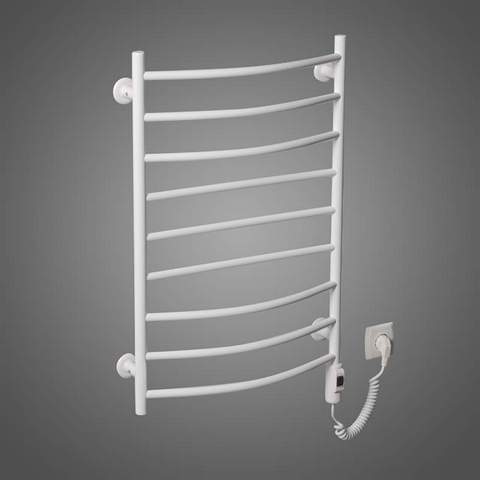

Which of these options do you have?
Having understood what kind of electric heated towel rail you own, we begin to look for a malfunction.
Checking the wiring. Maybe due to prolonged use, the wiring melted somewhere, and it automatically turned off.
How to understand this? Plug the device back in. If it knocks out, then most likely we have problems with the wiring.
Diagnostics with a multimeter
We set up the device to measure the DC resistance.
We take out the cord of the heated towel rail from the outlet and measure the resistance of the heating element and the wire.
The resistance of the heating element should be close to zero and be less than 1 Ohm. The resistance of the wire should tend to infinity.
We replace the damaged wiring. It is not difficult if the wiring is outside.
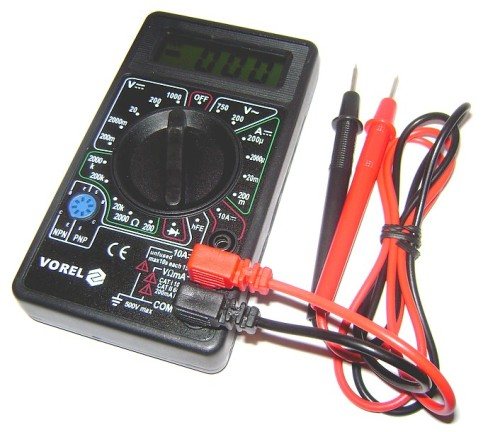

Replacing a faulty heating element
If the heating element shows high resistance, it means that it is broken. It needs to be replaced. It is not always possible to replace the heating element.
This will only work if the design allows it. Otherwise, you need to buy a new heated towel rail.
Let's say we are lucky and the heating element can be changed. Then we just unscrew the old heating element and put a new one. We do all the work slowly and carefully. We handle liquid heated towel rails with particular care. It is important not to damage the various gaskets and rings.
Criteria for choosing a heated towel rail for a bathroom
The durability of the heated towel rail depends on its initial characteristics and compliance with the installation technology. An important role will be played by the compliance of the selected model with operating conditions.
When choosing plumbing equipment, special attention should be paid to the principle of operation, material of manufacture and configuration of the heated towel rail.
Principle of operation and technical characteristics
All models of "towel dryers" for the bathroom are divided into three types:
- water;
- electrical;
- combined.
Water units operate by circulating a hot coolant. The connection is made through a heating or water supply system. The main advantage of such models is energy saving. The disadvantage of a water heated towel rail is the complexity of installation, if the device is not initially included in the communication system of an apartment or house.
In modern apartment buildings, the pressure in the hot water supply system is about 8-10 atmospheres, and in the buildings of the old fund - 5-7 atmospheres. Most of the imported models of heated towel rails have a low working pressure, and the pipe wall thickness does not exceed 1.25 mm. The service life of the device in a typical high-rise building is 1-2 years.
The choice of a coil for a private house is quite extensive, since the pressure in the autonomous heating system is low.
An electric heated towel rail operates autonomously, regardless of the operation of other systems. For work, you need an uninterrupted supply of electricity.
The use of the device is advisable in the following cases:
- fast installation is required without interfering with the heating or water supply system;
- installation of a "backup" heated towel rail;
- the need to place the coil outside the bathroom - a portable electric drying model is optimal.
To avoid excessive consumption of electricity, the unit should be selected according to the volume of the room. Optimally, if for 1 sq.m accounts for 140 W of energy - under such conditions, the bath heats up to 22-24 °. If a heated towel rail is needed for the spring and summer period, then low-power models are suitable at the rate of 100 W per 1 sq. m.
Power of "wet" models reaches 2 kW, "dry" devices - 100-200 watts.
Combined heated towel rails are capable of operating in two modes: from the network or from the hot water system. This is the most practical and efficient heating option, but the high cost of the universal coil has put off many buyers.
Plumbing device material
In the manufacture of a heated towel rail coil, three metals are usually used:
- stainless steel;
- copper and brass;
- black steel.
Stainless steel appliances are resistant to moisture, but susceptible to impurities in the water. Over time, sediment forms on the inside of the coil walls, restricting the path of the water flow.
Choosing a stainless steel heated towel rail, preference should be given to chrome-plated models with a wall thickness of 2 mm or more.
Radiators made of brass and copper are distinguished by high heat transfer, however, they have a limited life. When buying, you must check the passport of the product. It must indicate that the pipes are galvanized from the inside and the heated towel rail is suitable for tapping into the DHW system.
Black steel is capricious to the coolant. Models made of such material are recommended for installation in an autonomous heating system, where pressure drops are excluded. It is permissible to connect a coil with internal anti-corrosion protection to the central DHW system.
Dimensions and shape of the heated towel rail
Size and configuration are based on the location of the dryer, the size of the tub, and personal preference. In addition, it is necessary to take into account the way of insertion: side, diagonal, top or bottom.
Classic M- and U-shapes are affordable and are optimal for replacing worn-out Soviet coils. The "ladder", "foxtrot" and "modern" radiators are more spacious. The area allows you to place the laundry like a stationary dryer.
The heated towel rail should be compatible with the bathroom design and not clutter up the space.
A heated towel rail is leaking at the junction, what should I do? Step-by-step instruction
The heated towel rail is located in the bathroom and is a curved pipe of various configurations through which hot water flows. It heats the room and at the same time it is possible to dry wet towels and linen on it. The most common malfunction is leakage at the joints of the structure.
Views
Heated towel rails are:
- electric, working as heating radiators.
- water, functioning due to the heating system or hot water supply.
- combined, operating both from heating or water supply and from the mains.
Made of stainless steel, copper, chrome-plated brass, aluminum and enamelled steel. With different thickness, metal quality and service life.
The reason for the leak at the joints
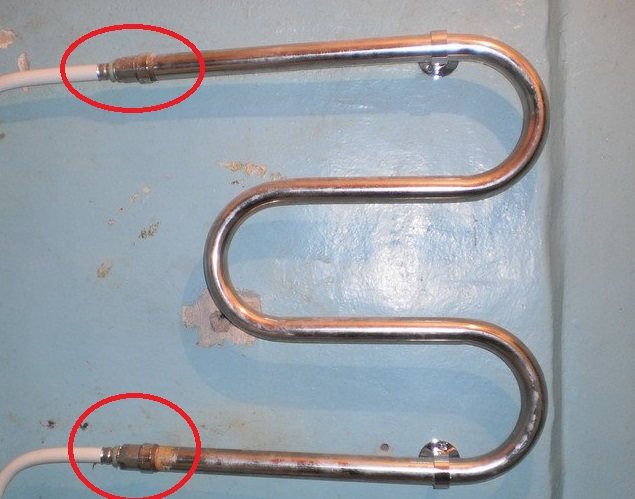

Leaking heated towel rail at the joints
Due to the constant heating of the heated towel rail, its parts are subject to thermal expansion, increased pressure in the system and corrosion.
- Damage at the joint or corrosion of the pipe body.
- Water hammer or sudden increase in pressure within the system.
- Wear in places of sealing.
- Factory defect or poor quality installation.
Eliminating the leakage of a heated towel rail with your own hands


Do-it-yourself leak elimination
- If the cause is damaged parts or corrosion, then these parts need to be replaced. With severe wear of the structure, a complete replacement of the entire heated towel rail is required. If a leak occurs on a flat section of the pipe, it is possible to install a coupling after cleaning and degreasing the problem area. But you need to remember that this is a temporary measure. And such a heated towel rail should be replaced with a new one.
- Leakage can occur when the pressure inside the system rises sharply. Therefore, it is recommended to install a hydraulic protection system at the entrance.
- In the event of a leak in the places of sealing, it is necessary to turn off the water supply, disassemble the structure and replace the worn out parts with the installation of new silicone or rubber gaskets. Also use tow or red lead. In case of leaking joints on polypropylene pipes, heat the joint with a construction hairdryer and install a clamp of a suitable size. Or cut the problem section of the pipe and install a new one.
- Leakage due to a factory defect is not an uncommon cause. Therefore, you need to purchase products that have a quality certificate and a guarantee. In case of a poor-quality installation, it is possible to eliminate the leak by reinstalling. If there is a leak in the nut joint, eliminate it by applying an additional layer of sealant or tow. Or by tightening the nut connection more tightly. If the leak occurs due to improper installation of the structure with a bias, it is necessary to reinstall the heated towel rail completely. And be sure to take into account that the diameter of the heated towel rail pipe must exactly match the diameter of the pipes of the main water supply system.
www.moy-house.ru
Connecting a heated towel rail: DHW or heating
Before you install a water heated towel rail in the bathroom, you need to decide on the method of connecting it.
There are two options available:
- Connection to the DHW system. The method guarantees year-round heating. The device heats up when hot water is consumed - overnight the heated towel rail cools down even if it is directly switched on through the riser.
- Insert into the heating system. The option is relevant in the absence of a centralized hot water supply network. Thanks to the forced circulation of the coolant, the coil remains warm around the clock. The disadvantage is that drying functions only in the cold season.
When replacing the method of connecting a heated towel rail in an apartment building, you will need to develop a project and approve it in housing and communal services. Registration of the package of documents will take about a month.
General installation requirements
Installation of a heated towel rail with a "water" principle of operation is carried out in compliance with a number of conditions:
# 1. The diameter of the pipes of the device must correspond to the diameter of the riser; tapering from the installed fittings is unacceptable.
No. 2. It is necessary to provide a jumper between the drying outlets. The bypass performs a number of tasks:
- maintaining the rate of water circulation throughout the riser;
- separation of coolant flows allows you to keep heat for subsequent points of water intake;
A weighty plus of switching on the closing sections, bypasses, is the ability to turn off the heated towel rail for repairs without stopping the operation of the system as a whole.
No. 3. It is forbidden to install shut-off valves in the pipeline section up to the bypass and directly on the bulkhead.
Failure to comply with the requirement entails:
- slowing down the circulation of water through the riser and a drop in the temperature of the coolant;
- deterioration of pressure in apartments located in the direction of the water supply.
The closing sections can be equipped with the usual ball valves on the bypass and supply line, or more functional three-way valves, allowing the coolant to be directed either to the bypass or to the radiator.
No. 4. The recommended height for drying towels according to SNiP is 120 cm from the floor.
No. 5. Limit distances between the heater and the wall cladding:
- 3.5-4 cm - if the diameter of the coil is 2.5 cm or less;
- 5-7 cm - with a pipe section of more than 2.5 cm.
If a bypass is provided in the wiring diagram, then shut-off ball valves can be installed at the outlet and inlet of the device.
The most common causes of breakdown
The main cases of a heated towel rail breakdown include:
- Lowering the temperature regime of operation.
- Lack of water circulation in the heated towel rail.
Since in this article we will analyze the question of the reasons why water does not circulate in the heated towel rail, therefore, we will analyze the second case. So. the main reasons for this breakdown include:
- Stopping circulation in the mechanism, which is connected to the bath radiator.
- The appearance of a plug from the air.
- Plugging of pipelines that supply water to the heated towel rail.
- Breakage of the valve of the control-filling type, which is installed on the device.
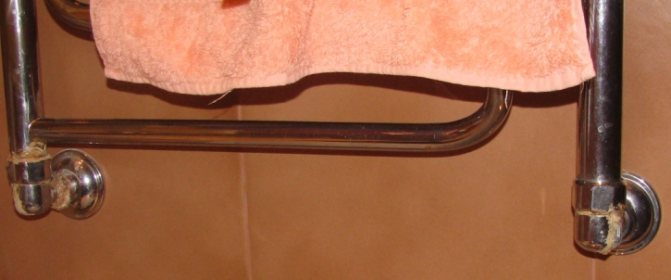

Recommended and Invalid Punching Schemes
The principle of the "gravity pump" is the cornerstone of the coil's performance. A competent inset ensures natural circulation and performance of the radiator. The development of a DIY installation scheme for a water heated towel rail is carried out in accordance with the design of a specific model and the location of the riser in the bathroom.
Side and diagonal connection
For most devices, a tie-in with a coolant supply through the upper outlet and outlet from the bottom is considered optimal. This is achieved with universal connections, the diagrams of which are shown below.
Benefits of the universal tie-in:
- performance does not depend on the direction and rate of water supply in the riser;
- after turning off the circulation, air bleeding is not required;
The universal version of the tie-in allows you to position the heated towel rail at any distance convenient for installation from the riser.
Conditions for the operation of the circuit:
- The lower point of the tie-in is located below the connection pipe to the radiator, and the upper tie-in, respectively, is above the upper outlet. The slope of the supply pipes is 2-3 cm per meter. The horizontal connection is permissible for pipes with a cross section of 32 mm, as well as if the distance to the riser is less than 2 m.
- Supply pipes - no kinks or humps. Otherwise, the system is airborne and natural circulation stops.
- The optimal diameter of the supply pipes: ¾ inch steel, 25 mm - reinforced polypropylene.
- It is advisable to insulate the pipes. This requirement is especially important for hidden installation of a plastic pipeline.
A fully functional side / diagonal tapping scheme with a narrowed bypass. Plumbers resort to this design on a previously installed heated towel rail, if there is no need to completely change the design of the riser.
Displacement of the bypass is justified if you want to keep the old supplies to the riser. With this method of connection, it is not recommended to use a narrowed jumper. The main requirement is the upper supply of the coolant.
Some models of dryers are designed for bottom connection. The insertion is carried out according to three main schemes.
Bottom connection implementation requirements:
- The lower outlet must be located below the heated towel rail.
- It is advisable to insulate the supply pipes.
- The top outlet of the riser pipe, when using an offset or narrowed bypass, is located below the point of connection to the instrument.
The optimum slope is about 2 cm per meter of pipe. The fulfillment of this condition ensures the independence of the circuit from the direction of the water flow.
Possible forced tie-in options
With lateral connection, some deviations from the typical recommended circuits are permissible.
The basic conditions of the tie-in remain unchanged. The difference is in the points of connection of the heated towel rail with the riser, as well as in the presence of vertical sections at the inlet and outlet of the device.
An alternative sidecut is shown below. The top of the heated towel rail is located above the upper outlet. After turning off the water, it will be necessary to bleed air from the coil.
The lower inset can also be somewhat modified. The need to place pipes from the riser at a minimum distance to the floor forces both ascending piping to be increased. If all the requirements of the bottom connection are met, the system works without failures.
Incorrect wiring diagrams
Inexperienced craftsmen sometimes do not adhere to the recommended schemes.As a result, the drying remains cold with an uninterrupted supply of hot water. Examples of possible omissions are shown below.
In both versions, the device is located below the lower outlet from the riser. The coolant descending downward cools and becomes trapped. The water is not pushed back, since there is the pressure of the coolant flow from above.
Air accumulates in the formed "hump". Over time, the air lock shuts off the circulation in the radiator and the heated towel rail cools down.
The variant presented below combines two errors at the same time. The scheme is obviously not working.
Why the heated towel rail does not heat (video)
In this article, we have considered only some of the large variety of reasons for the failure of the device. Only a specialist who will competently and accurately cope with the task assigned to him will help you to identify, and in the future and eliminate any reason.


Whichever way the water heated towel rail is connected: from the side, bottom or diagonally, in the riser, between the terminals for connection, a narrowing must be made
and it should be 1 diameter less than the riser pipe - this is the basis of the basics!
The diagrams with the connection show the connection methods and the narrowing on the riser, but it is not shown that for the natural circulation of hot water, the pipes to the heated towel rail must be laid at a slope, if this is not possible, then you will have to bleed the air from the system more often.
If there is no narrowing between the taps, then the water, without experiencing obstacles, flows in a straight line and the heated towel rail will be slightly warm. (SNiP water supply and sewerage clause 5.7.) Shut-off taps should be installed at the branches from the riser, and not in any case not on the riser itself - for this you can get a fine from the management company.
If you are just planning to install a heated towel rail, then watch the video below!
Step-by-step installation of a water heated towel rail
The technology for installing a water heated towel rail with your own hands is the same for different connection schemes. The step-by-step course of work includes dismantling a worn-out device, supplying pipes from a riser, installing taps and fastening a coil.
Preparation of tools and materials
The set of tools required to install and replace a heated towel rail depends on the type of water pipes in the room. For installation through polypropylene pipes you will need: ball valves; mounting brackets; polypropylene pipes; soldering iron and knife for cutting PP pipes.
The standard equipment for a heated towel rail includes:
- transition corners;
- silicone gaskets;
- locking nodes;
- telescopic brackets;
- crane "Mayevsky".
It is advisable to use single metal components in the system to avoid electrolytic corrosion.
Dismantling of old equipment
Before dismantling an obsolete coil, it is necessary to coordinate actions with the house management organization. Disconnecting the riser from the water requires a special permit.
Following actions:
- If the towel dryer is not integral with the hot line, then the screw connections just need to be unscrewed.
- If the device is welded to the riser, then it should be cut off with a grinder. The remainder of the pipe feed should be sufficient for threading.
- Remove the old device from the brackets.
The cutout in the riser in height must exceed the distance between the nozzles of the new device by the length of the couplings and squeegees required for inserting the bypass jumper
Installation of bypass and ball valves
The coil can be fastened without installing a bypass, but experts recommend that a jumper be provided in advance. Ball valves are installed at the ends of the heated towel rail. If necessary, it will be possible to shut off the coolant supply to the device, while water will circulate freely through the riser.
To install taps on pipe sections, cut a new thread using a die of the required diameter. If, after dismantling the old device, the thread has survived, then it is enough to "drive" it with a die to improve the connection. Install shut-off valves on the prepared pipes.
Attaching the heated towel rail
The procedure for "hanging" and connecting the device is as follows:
- Apply markings on the wall for the brackets - it is necessary to observe the horizontal position of the coil.
- Prepare holes and insert dowels into them.
- Screw the brackets to the heated towel rail, attach the device to the wall and fix with screws. It is important to adhere to the recommended distance between the radiator and the wall cladding.
- Connect the unit to the valves on the lintel using fittings, seal the connections with linen tape.
Straight or elbow threaded fittings are used depending on the type of connection.
Features of installing electrical models
Unlike water models, electric dryers can be installed anywhere, since they do not depend on the location of heating pipes and hot water supply. In this case, special attention should be paid to the quality of the wiring.
Installation requirements for electric heated towel rails:
- The place of installation is selected taking into account the level of protection of the device against moisture. The distance to the bathroom or washbasin is at least 60 cm.
- The minimum distance to the floor is 20 cm, to the wall - 30 cm, to the surface of furniture - 75 cm.
- The heating device must not be placed directly under the socket.
The connection to the mains is carried out in accordance with the international standard NFC-15-100.
Wiring under the heated towel rail is carried out in compliance with electrical safety standards in rooms with high humidity:
- connection via a three-core cable with grounding;
- only hidden wiring is permissible;
- the socket must have a rubber seal and a cover that covers the contact holes;
- copper wires of the VVGng and VVGng-LS brands are used for the power grid.
A prerequisite for the installation and operation of electrical devices is the use of an RCD that turns off the device when the current operating characteristics are exceeded.
Useful video on the topic
Recommendations for choosing a towel dryer are shown in the video clip:
The installation process of a water heated towel rail is shown in the video clip:
The technology for installing a heated towel rail depends on the selected model. The performance of a water device is determined by a well-designed and executed tie-in scheme. When installing an electric model, special attention is paid to operational safety. It is better to entrust the installation of the combined "coil" to professionals.
sovet-ingenera.com

